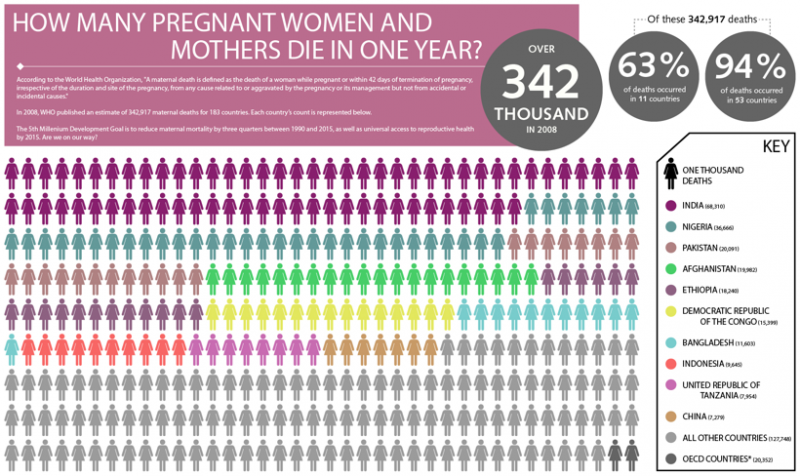
<a href="http://maternalhealthtaskforce.org/images/infographic%20one%20year.jpg">Maternal Health Task Force</a> via Fair Use
Today I stumbled upon this nicely designed infographic by the Maternal Health Task Force on annual maternal deaths globally. According to the graphic, India comes in first in maternal mortality with 68,310 deaths a year, followed by Nigeria (36,666) and Pakistan (20,091). These numbers are absolute totals, so it makes sense that India would have the most maternal deaths: they have the most deaths because they have the highest population. If you look at these numbers per capita instead of as totals, the context changes somewhat.
For example, using the same WHO/UNICEF/UNFPA/World Bank report the infographic was based on, India’s per capita maternal mortality rate in 2008 was actually middle-of-the-road at 230 deaths per 100,000 people, while Nigeria’s was much higher (840 per 100,000). So while the graph shows that India has the most maternal deaths in the world, it may be much riskier to be a mother in a country like Afghanistan (1400 deaths per 100,000) or Somalia (1200 deaths per 100,000).
It’s also compelling that the OECD countries (developed countries with high standards of living) make up such a small portion of deaths in the chart. This is true by absolute numbers of deaths, but it’s notable within the OECD group there is a decent amount of variance. For example, most OECD countries have very low death rates: Sweden has 5 maternal deaths per 100,000 people, Greece has 2, and Ireland has 3. The US is at the high end of the OECD range, with 24 deaths per 100,000: the same rate as Saudi Arabia and nearly five times Sweden’s rate.
I guess my point here is that there are lots of ways to juggle the numbers, and ultimately I find the death rate per capita more useful than the total number of deaths. I also think charts like these obscure the point that the relative wealth and size of a country do have an affect on its maternal mortality, but they’re not everything. At the end of the day, I find it disheartening that a rich country like the US, which prides itself on its treatment of women, has the same maternal mortality rate as a country that doesn’t let women drive and a worse rate than countries with a fraction of its GDP per capita.














